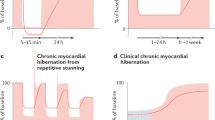Abstract
One picture may be worth a thousand words, as they say, but I was asked to write the thousand words and not to provide the picture. My major point can in fact be made in even fewer words. Despite the unanimous acceptance of the standard definition of stunning (1), it appears that this includes vastly different experimental and clinical conditions. Regarding the definition-according to Bolli (1), it is a state in which myocardial blood flow is fully restored following prior ischemia and during which time myocardial mechanical function is depressed. A further feature is that there is no evidence of myocardial necrosis.
The range of experimental conditions covered by this definition is demonstrated by Lavellee et al. (7) who showed progressive recovery following 1 h of coronary artery occlusion in a dog, and a state of stunning lasting at least 2 weeks. As expected with such prolonged periods of ischemia, where there must be some necrosis, mechanical recovery was incomplete. Presumably, however, there was no necrosis in the segments that did recover. In contrast, Du Toit and Opie (4) used an isolated rat heart model with 20 min of global ischemia in which stunning lasted for only about 1 h. Other workers using dog models (11) have described intermediate durations of stunning of some hours, even following a short period of coronary occlusion such as 15 min.
Likewise, clinical stunning may last for only short periods, such as following the severe ischemia caused by balloon inflation during angioplasty which causes transient diastolic dysfunction (8). It is likely that the transient dys function observed after an attack of angina pectoris also falls into the short-term category of stunning. At the other extreme is prolonged ischemia over hours, days and possibly weeks following thrombolytic therapy or cardioplegic bypass (3, 8).
In principle it seems unlikely that the same processes would be at work in a short-term, self-correcting phenomenon as in a more complex, long-term, and only partially self-remedying phenomenon. It therefore seems appropriate to distinguish between acute short-term and chronic long-term stunning.
Similar content being viewed by others
References
Baxter GF, Marber MS, Patel VC, Yellon DM (1994) Adensone receptor involvement in a delayed phase of myocardial protection 24 hours after ischemic preconditioning. Circulation 90: 2993–3000
Bolli R (1990) Mechanism of myocardial “stunning”. Circulation 82: 723–738
Braunwald E (1990) The stunned myocardium: newer insights into mechanisms and clinical applications. J Thorac Cardiovasc Surg 100: 310–311
Du Toit EF, Opie LH (1992) Modulation of severity of reperfusion stunning in the isolated rat heart by agents altering calcium flux at onset of reperfusion. Circ Res 70: 960–967
Du Toit EF, Opie LH (1994) Inhibitors of Ca2+-ATPase pump of sarcoplasmic reticulum attenuate reperfusion stunning in isolated rat heart. J Cardiovasc Pharmacol 24: 678–684
Hearse DJ (1991) Stunning: a radical review. Cardiovasc Drugs Ther 5: 853–876
Lavallee M, Cox D, Patrick TA, Vatner SF (1983) Salvage of myocardial function by coronary artery reperfusion 1, 2 and 3 hours after occlusion in conscious dogs. Circ Res 53: 235–247
Patel B, Kloner RA, Przyklenk K, Braunwald E (1988) Postischemic myocardial “stunning”: a clinically relevant phenomenon. Ann Intern Med 108: 626–628
Schaper W (1991) Molecular mechanisms in “stunned” myocardium. Cardiovasc Drugs Ther 5: 925–932
Shen Y-T, Vatner SF (1995) Mechanism of impaired myocardial function during progressive coronary stenosis in conscious pigs. Hibernation versus stunning? Circ Res 76: 479–488
Triana JF, Li XY, Jamaluddin U, Thornby JI, Bolli R (1991) Postischemic myocardial “stunning”. Identification of major differences between the openchest and the conscius dog and evaluation of the oxygen radical hypotheesun the conscious dog. Circ Res 69: 731–747
Vanoverschelde J-L, Wijns W, Depre C, Essamri B, Heyndrickx GR, Borgers M, Bol A, Melin JA (1993) Mechanisms of chronic regional post-ischemic dysfunction in humans. New insights from the study of noninfarcted collateral-dependent myocardium. Circulation 87: 1513–1523
Author information
Authors and Affiliations
Rights and permissions
About this article
Cite this article
Opie, L.H. Chronic stunning: The new switch in thought. Basic Res Cardiol 90, 303–304 (1995). https://doi.org/10.1007/BF00797907
Issue Date:
DOI: https://doi.org/10.1007/BF00797907




